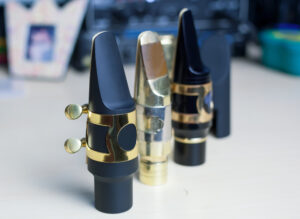For as long as the clarinet and saxophone have existed, cane has traditionally been the material of choice for reeds. This is because cane has the properties to vibrate well with air and create a great sound when those vibrations travel through an instrument. In the last couple decades, a new contender has emerged: plastic reeds. At first, they were mocked as a joke. Now, Légère’s plastic reeds are being used by some of the greatest clarinetists and saxophonists in the world. So, how do we decide on which reeds to use?
For your clarinet or saxophone lessons in Seattle, here are some tips to help you learn more about plastic reeds and if they are a proper fit for your student. It is important to note that plastic reeds tend to feel softer than cane reeds, so, as a Seattle saxophone teacher, I would recommend trying a plastic reed that is a size 0.5 bigger than your preferred cane reed size.
Better Sound?
Traditionally, the biggest benefit to cane reeds is that they generally tend to produce a better sound quality than plastic reeds. There are a lot of factors that influence this sound quality, but when it comes to comparing reed material the big one is your mouthpiece. Cane reeds tend to sound better on most mouthpieces, but on some mouthpieces plastic reeds will actually sound noticeably better. This is due to unique microscopic proportions in your mouthpiece and the individual cane or plastic reeds that are impossible to measure with accuracy. So, how do we get around this? The answer is: try both types of reeds with your current mouthpiece! Compare one Légère plastic reed with 2-3 cane reeds, and your saxophone student will be able to decide which material of reed is best for them.
More Stability
The biggest benefit to plastic reeds is that they hold their form, and they are more stable than cane reeds. Cane reeds tend to become significantly less effective than their prime after about 6 to 9 months. And even then, it takes them a few playing sessions to break them in when they are new. Throughout their entire lifespan, cane reeds go through very minor transformations – some good, and some bad. Plastic reeds are the same every day and they do not die like cane reeds do, so you can rely on a plastic reed to play the same every time your student uses it in their saxophone or clarinet lessons in Seattle.
There’s a Big Difference in Price
As you may or may not already know, cane reeds cost about $3-5 each depending on which instrument you play, or box of 10 of for around $30. A single plastic reed will generally cost about the same at approximately $30. This may sound too expensive right off the bat, but if your student is interested in using plastic reeds this may actually be a good investment for you. There are a couple things to keep in mind here:
- Plastic reeds last a lot longer than cane reeds, potentially for years.
- They are a lot harder to destroy. One would actually have to try to destroy one, whereas cane reeds are often ruined by accident.
- They make an excellent backup reed in case anything happens to your cane reeds.
Best Times To Use A Plastic Reed
If your student uses cane reeds normally, there are couple of special situations where using a plastic reed instead is especially useful:
- If your student is involved in marching band, plastic reeds are perfect due to their durability. You will likely end up saving money compared to cane reeds.
- If your student plays in musical theatre or jazz bands often where they need to switch instruments frequently, the fact that plastic reeds do not need moisture will make their lives easier.
There are a lot of reasons that plastic reeds are great for some, but there are also many reasons that one would not want to use plastic reeds. Either way your student ends up deciding, they are certainly worth your consideration. Ten years ago, using a plastic reed sounded like a joke. Now thanks to Légère’s groundbreaking work on their plastic reeds, they have become a serious option for some of the best players in the world. They may even be the best option for you or your student. Contact us today to find out more about our teachers! They can either come to your home to teach or can also provide online music lessons. Our virtual music lessons are taught by local music teachers who plan their lessons to suit your child.
By Brian Schappals
